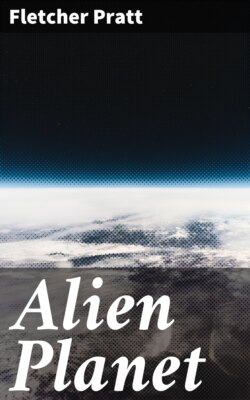Читать книгу Alien Planet - Fletcher Pratt - Страница 4
На сайте Литреса книга снята с продажи.
PROLOGUE
ОглавлениеTable of Contents
Those who followed the technical periodicals during the Thirties know that the Hudson-Bird expedition to Central Asia was most successful, scientifically. But there is one result of the expedition’s labors which is now being given to the world for the first time. Briefly, its history is this:
While the expedition was in Mongolia, Professor Hudson was visited one night by the headman of a small village near Kiakhta. The headman’s only son was, it appeared, going blind. Professor Hudson acceded to the headman’s request for aid (for some reason the man thought Hudson to be in league with the powers of the air) and found that the boy was suffering from ophthalmia. Hudson treated him and left some eye-wash with the chieftain, to be used with certain incantations which the professor invented on the spur of the moment to make certain that the eye-wash was used properly and not drunk.
There was some difficulty about the camel-train at this point and the expedition was forced to remain in the neighborhood for three weeks. The headman, whose son had now completely recovered, became almost embarrassing in his gratitude, and capped the climax by offering to present Professor Hudson with a stone that had fallen from the skies. Thinking it might be of some interest as a meteorite, the professor accepted the offer, and the next day the headman arrived with the stone, which was about thirty inches in diameter, roughly prolate in shape and deeply pitted. It was packed with other specimens and forgotten for a time.
During the return journey, while the expedition was descending a pass in the Great Khingan, one of the pack animals, becoming frightened at a bird which swerved near, lost its footing and tumbled from a ledge into a rocky valley a hundred feet below. The animal was killed, and the case it carried burst. Among the contents was the meteorite which the headman had presented to Professor Hudson. It struck on a projecting pinnacle of rock and a piece was broken off: Upon retrieving it, members of the expedition noted that the surface of the break was clearly metallic and not at all like that of the average meteorite, and further examination revealed it to be faintly radioactive.
Subsequent chemical examination showed that the meteorite was in fact composed of a perfect alloy of tantalum, platinum and other metals, with a small quantity of uranium X present (which accounted for the radioactivity). The combination was so exceedingly curious that Professor Hudson had it cut in two for further examination upon the arrival of the expedition in New York.
It proved to be hollow, and within the central core were several extremely thin sheets of nickel closely covered with minute writing. To the astonishment of those present, the writing, on being placed under a magnifying glass, proved to be in English. It had been applied to the metal by some means, chemical or mechanical, whose exact nature is not known.
The present narrative is a recension of that found on the nickel sheets. It tells its own story. The internal evidence of its authenticity is good; it was apparently begun at some leisure (even with an eye to publication) and finished in haste and under the shadow of some overwhelming event. The account holds together as a whole; it has no scientific inaccuracies that can be checked, except insofar as it disagrees with the Einstein theory of velocity in empty space, and this disagreement is explained in the narrative itself.
However, at points in the narrative, some sheets are missing, so that it has been necessary for the transcriber to condense and summarize. In addition certain restrictions were placed upon the transcriber by the conditions under which the sheets were turned over to him after Professor Hudson’s death.
In the letter accompanying the sheets, Hudson tells of his attempts to check external evidence. No traces could be found at Joyous Gard, but a broker named Alvin Schierstedt disappeared from a cottage on Sunderland Lake under circumstances of considerable mystery in 1920. The only Merrick Wells, lawyer, who was in practice at the time, and might have supplied the final check, acknowledging that he was the Merrick Wells of this story, was killed in an aviation accident in the spring of 1928. Due to the lack of corroborating evidence, as well as to material which the transcriber was bound to admit, Professor Hudson and his colleagues decided to postpone publication of the narrative of Alvin Schierstedt during their lifetime.
The actual transcribing of the manuscript on the nickel plates was a matter of no small difficulty, particularly as the writing was in an exceptionally illegible hand. After some experiment, the happy idea of putting the sheets in an old-fashioned magic lantern (so arranged as to give a positive instead of a reversed image) was hit upon. A friend worked the lantern and I sat before the screen transcribing the manuscript direct on the typewriter. The writing, which was not very good in the first part, became worse as the manuscript continued, and finally so bad that a considerable portion had to be omitted entirely. The division into chapters, was, at the beginning, the work of the author—Mr. Schierstedt. Toward the end, the division is mine, as a large portion of the latter part was lumped in a single connected whole.
Fletcher Pratt.
